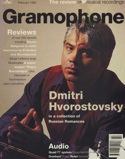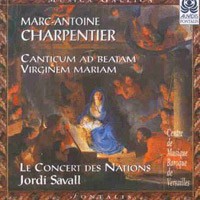Texte paru dans: / Appeared in: |
|
|
Reviewer: Nicholas Anderson
The two most extended pieces are the Canticum in honorem Beatae Virginis Mariae and the Litanies de la vierge. The Canticum is an intimate yet ardent work in the form of a dialogue between man and angel s. Charpentier was exceptionally skilled in this kind of little drama and Jordi Savall's musicians, Le Concert des Nations, inject a lively sense of theatre . The Litanies , the most elaborate of nine settings by Charpentier, is that which William Christie and Les Arts Florissants recorded on a recent Harmonia Mundi disc. The work probably dates from the early- to mid-1680s when Charpentier was serving in the household of the Duchesse de Guise. There are some radiant moments in this skilfully contrapuntal work but also moments of profound contemplation as, for instance in the "Rosa mystica".
Profoundly meditative too, is the Stabat mater pour des religieuses, scored for soprano soloist with unison soprano chorus. Both in spirit and in the disposition of upper voices the music is closely allied with Charpentier's works for the nuns of the convent of Port Royal. Savall includes male voices for the ensembles but retains the soprano for the serene and ethereal solos. It is a very beautiful composition and hearing it on France Musique shortly before midnight took my mind off one of the worst meals I have ever eaten in a country renowned for its cuisine. The first two verses, incidentally, are included in a first-rate programme of music for Port Royal which I reviewed in January 1989 (Ricercar/ Harmonia Mundi); but I welcome Savall 's performance of the full text for, although Charpentier left music only for the two opening verses, he surely intended the same musical scheme to be adopted throughout.
The remaining pieces are of a disparate character underlining the richly expressive vocabulary on which Charpentier seems effortlessly to have drawn . Readers who are managing to keep abreast of the veritable explosion of recordings of music by this astonishingly prolific and gifted composer will find in these performances a Mediterranean passion, an urgency to communicate and an expressive intensity which are hard to resist. Savall generates excitement, and a sense of occasion with interpretations which make the listener feel that he or she is present, a bystander at an occasion of moment. These artists are sensitive to sonority and forceful in declamation as we can very quickly hear in the admirably sustained singing of the poignant Salve regina with its beguiling chromaticisms, searing dissonances and supplicatory outbursts. Savall affords prominence to the theorbo in his continuo realizations and uses viols rather than violins in the few instances here where treble instruments are required ; only in the Litanies does Charpentier specify treble viols .
To sum up, I found myself
captivated by these performances in spite of occasional patches of rough
ensemble and vocal insecurity. This is a warm-blooded view of Charpentier free
from preciosity, stylish and revelling in the many-sided character of the music.
The booklet is well documented with full texts in several languages and the
recorded sound truthful to voices and instruments alike. In a word,
irresistible. |
|
|
|
|
|
Cliquez l'un ou l'autre
bouton pour découvrir bien d'autres critiques de CD |
|




